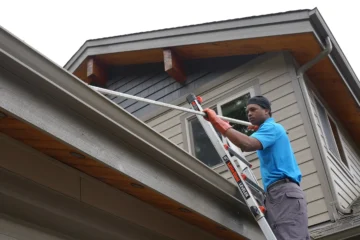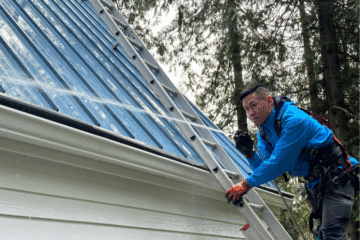“How often should I clean my gutters?” It’s one of the most common questions homeowners ask—and for good reason. Clean the right amount and you protect your home from thousands in water damage. But if you clean too infrequently, you’re risking your foundation, roof, and siding. On the other hand, cleaning too often wastes time and money.
The answer isn’t one-size-fits-all. Your ideal gutter cleaning schedule depends on several factors: the trees around your property, your local climate, your gutter system, and even your home’s location. Here in the Pacific Northwest, we face unique conditions that affect how often gutters need attention.
Let’s break down exactly how often you should clean your gutters—and why timing matters so much.
The General Rule: Twice a Year Minimum
According to home maintenance experts, gutters should be cleaned at least twice a year—once in late spring and once in fall. This baseline schedule works for most homes and protects against the primary threats gutters face throughout the year.
Spring Cleaning (Late April to May): This removes debris from winter storms, tree blossoms, seed pods, and early spring growth. As a result, your gutters are ready for spring rains.
Fall Cleaning (Late October to November): This is the most critical cleaning of the year. It removes accumulated leaves and debris before winter rains arrive, which helps prevent ice dams and ensures proper drainage during the wettest months.
For many Pacific Northwest homeowners, these two cleanings provide adequate protection. However, several factors might require you to clean more frequently.
When You Need More Frequent Cleaning
Homes with Pine Trees: Every Three Months
If you have pine, fir, or other evergreen trees near your home, your gutter cleaning needs increase significantly. According to Angi, pine trees shed needles year-round, so quarterly gutter cleaning helps prevent constant buildup.
Recommended schedule for homes with pine trees:
- Late Winter/Early Spring (March–April)
- Late Spring/Early Summer (June–July)
- Fall (October–November)
- Late Fall/Early Winter (December–January)
Pine needles are particularly problematic because they’re small enough to work their way through many gutter guards and create stubborn clogs that block water flow.
Heavy Tree Coverage: Three to Four Times Per Year
Homes surrounded by deciduous trees—maple, oak, alder, and others common in the Pacific Northwest—may need cleaning three to four times annually. Wooded areas with heavy leaf drops often require more frequent maintenance to keep water flowing properly through gutters and downspouts.
Signs you need more frequent cleaning:
- Trees overhang your roof
- Multiple large trees within 20 feet of your home
- Visible leaf accumulation in gutters between cleanings
- Overflowing water during moderate rainfall
Older or Damaged Gutter Systems
Gutters that are older, improperly sloped, or show signs of wear may need more frequent attention. These systems trap debris more easily and develop problems faster than well-maintained gutters.
Consider more frequent cleanings if your gutters:
- Sag or pull away from the roofline
- Have visible cracks or separations
- Lack proper slope for drainage
- Feature outdated mounting systems
Seasonal Breakdown: What to Expect Throughout the Year
Understanding what happens to your gutters each season helps you plan the right maintenance schedule.
Spring (March–May)
What’s Happening: Winter storms leave behind twigs, moss, and organic debris. In addition, trees bloom and drop seed pods, blossoms, and early leaves. Spring rains then test your gutter system’s capacity.
Why Clean Now: Preparing for increasing rainfall ensures water drains properly when spring showers arrive. Removing winter accumulation also prevents clogs during the heaviest spring rain periods.
Best Timing: Late April to early May, after trees finish blooming but before heavy spring rains intensify.
Summer (June–August)
What’s Happening: Debris accumulation is lower than in other seasons, yet summer storms can still deposit twigs and leaves. Meanwhile, pine trees continue shedding needles, and bird nesting activity may leave debris.
Why Clean Now: Mid-summer cleaning is primarily for homes with pine trees or properties that showed problems during spring. Most other homes, however, can skip summer cleaning.
Best Timing: Late June to early July for pine-tree properties, or as needed based on visible accumulation.
Fall (September–November)
What’s Happening: This is the busiest season for gutter debris. Deciduous trees drop massive amounts of leaves; seeds and nuts accumulate; and early winter storms bring additional organic matter.
Why Clean Now: This is the single most important cleaning of the year. Fall cleaning prevents clogs before Pacific Northwest winter rains arrive and is essential for protecting your home from water damage during the wettest months.
Best Timing: Late October to mid-November, after most leaves have fallen but before heavy winter rains begin.
Winter (December–February)
What’s Happening: Wet, heavy debris accumulates from storms. In colder snaps, ice and snow can create ice dams in clogged gutters. Moss and algae growth also increases in wet conditions.
Why Clean Now: Most homes don’t need winter cleaning unless problems arise. Nevertheless, pine-tree properties or gutters showing overflow during early winter storms may need attention.
Best Timing: Only as needed for problem situations. Because winter gutter cleaning is more dangerous due to weather conditions, it should be handled by professionals.
Special Considerations for Pacific Northwest Homes
Our region presents unique challenges that affect gutter maintenance schedules:
Heavy Rainfall
The Pacific Northwest receives 150 days of measurable precipitation annually in many areas. Because of this constant moisture, clogged gutters cause damage faster than in drier climates. What might be a minor issue elsewhere becomes a major problem here.
Moss and Algae Growth
Our damp climate promotes moss and algae growth in gutters between cleanings. These organic materials create stubborn clogs and hold moisture against your fascia boards, causing wood rot. Regular cleaning therefore prevents this biological buildup.
Tree Density
Many Pacific Northwest properties feature dense tree coverage—Douglas firs, cedars, maples, alders, and more. While beautiful, this landscaping creates more gutter maintenance than properties in less wooded areas.
Ice Dams
While less common than in other regions, Pacific Northwest homes at higher elevations or during cold snaps can experience ice dams. Clogged gutters filled with debris provide the perfect conditions for ice dam formation.
How to Determine Your Personal Schedule
Use this decision tree to establish your ideal gutter cleaning frequency:
Start with the baseline: Two times per year (spring and fall).
Add one additional cleaning if:
- You have several large trees near your home
- Your property is in a heavily wooded area
- Previous cleanings showed significant debris accumulation
- You’ve experienced overflow during moderate rainfall
Add two additional cleanings (total of four per year) if:
- You have pine, fir, or other evergreen trees near your home
- Trees directly overhang your roof
- You live in a densely wooded area
- Your gutters showed problems with semi-annual cleaning
Consider professional assessment if:
- You’re unsure about your needs
- You’re new to the property
- Previous cleaning schedules didn’t prevent problems
- Your gutters frequently overflow despite regular cleaning
Signs You’re Not Cleaning Often Enough
Between scheduled cleanings, watch for these warning signs that indicate you need more frequent maintenance:
Visible Overflow During Rain: If gutters overflow during moderate rainfall, they’re clogged and need immediate attention.
Plant Growth in Gutters: Seeing plants or seedlings in your gutters means debris has accumulated long enough to support growth—so you’re waiting too long between cleanings.
Sagging Gutters: Excessive debris weight causes gutters to sag and pull away from mounting brackets.
Water Stains on Siding: Vertical staining below gutters indicates chronic overflow from clogs.
Foundation Pooling: Water pooling near your foundation after rain means gutters aren’t channeling water away properly.
Interior Water Damage: Ceiling or wall stains, especially near exterior walls, can result from overflowing gutters backing water under shingles.
If you notice any of these signs, schedule immediate cleaning and consider increasing your maintenance frequency going forward.
The Cost of Getting It Wrong
Cleaning too infrequently has serious consequences. As we covered in our article on the cost of clogged gutters, neglected gutters can cause:
- Foundation repairs: $2,200–$20,000+
- Water damage restoration: $1,305–$5,707
- Mold remediation: $1,200–$3,750
- Roof damage: thousands more in repairs
Compare these potential expenses to the cost of proper maintenance:
- Professional gutter cleaning: $150–$300 per visit
- Annual cost for twice-yearly cleaning: $300–$600
- Annual cost for quarterly cleaning: $600–$1,200
Even at the highest maintenance frequency, you’re spending a fraction of what a single repair would cost.
Professional vs. DIY: Making the Right Choice
Some homeowners handle gutter cleaning themselves, while others hire professionals. Your decision should consider:
Safety Concerns: Ladder accidents cause thousands of injuries annually. If you’re uncomfortable at heights, have a multi-story home, or face physical limitations, professional service is worth the investment.
Time and Equipment: Professional crews complete in hours what might take you an entire day. They also have commercial-grade equipment, proper ladders, and disposal solutions.
Inspection Value: Professional cleaners spot problems you might miss—loose fasteners, improper slope, early wood rot, and damaged components. Early detection, therefore, prevents expensive repairs.
Consistency: Professional service ensures gutters get cleaned on schedule, not only when you finally find time on a nice weekend.
Insurance Protection: Professional services carry insurance protecting you from liability if accidents occur. DIY cleaning puts all risk on you.
For most homeowners, professional gutter cleaning offers better value than DIY when you factor in safety, time, expertise, and early problem detection.
Creating Your Annual Gutter Maintenance Plan
Here’s how to establish a reliable maintenance routine:
Step 1: Assess Your Needs
- Count the trees near your home
- Note tree types (evergreen vs. deciduous)
- Review past gutter problems
- Determine your baseline frequency (2–4 times per year)
Step 2: Schedule Proactively
- Book spring and fall cleanings at the beginning of each year
- Add additional cleanings based on your property’s needs
- Schedule before busy seasons when services book up
Step 3: Conduct Visual Checks
- Between professional cleanings, visually inspect gutters monthly
- Watch for visible debris buildup or overflow during rain
- Note any concerns to discuss during the next cleaning
Step 4: Keep Records
- Document when cleanings occur
- Note any issues discovered during service
- Track whether your current schedule prevents problems
Step 5: Adjust as Needed
- If problems occur between cleanings, increase frequency
- If gutters remain clean at scheduled maintenance, your schedule is working
- Reassess annually based on changing conditions
Why Johnny Tsunami Recommends Twice-Yearly Minimum
At Johnny Tsunami, we’ve cleaned thousands of gutters throughout Kitsap County and Washington State. Our experience shows that twice-yearly cleaning (spring and fall) provides adequate protection for most Pacific Northwest homes without pine trees.
However, we always conduct thorough inspections during service and provide honest recommendations about whether your property needs more frequent attention. We’d rather tell you that your current schedule is working than push unnecessary service.
Our award-winning gutter cleaning includes:
- Complete debris removal from gutters and downspouts
- Visual inspection for damage or wear
- Testing to ensure proper water flow
- Professional recommendations for your specific property
- Photo documentation of our work
- Cleanup of all debris from your property
Take Action: Protect Your Home with Proper Maintenance
Don’t wait until clogged gutters cause expensive damage. Instead, establish a proper cleaning schedule now and protect your home year-round.
Most Pacific Northwest homes need gutter cleaning at least twice per year—in spring and fall. Properties with pine trees or heavy tree coverage need quarterly service. Your specific needs depend on your unique situation; however, waiting too long is never worth the risk.
Ready to establish a reliable gutter maintenance schedule? Get a free quote from Johnny Tsunami and we’ll assess your property’s specific needs. Our experienced team will recommend the right frequency for your home and ensure your gutters stay clean and functional all year long.
Schedule your next gutter cleaning today. Contact Johnny Tsunami for award-winning service that protects your home from water damage. We’ll help you create a maintenance schedule that keeps your gutters working properly without unnecessary expense.
Your home deserves proper protection. Let us help you get it right.
Johnny Tsunami provides professional gutter cleaning services throughout Kitsap County and Washington State. Our award-winning team helps homeowners establish proper maintenance schedules that protect their homes from water damage while avoiding unnecessary expense. Voted #1 Best Gutter Cleaning Service in Kitsap County.









